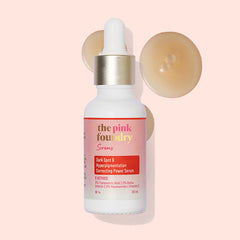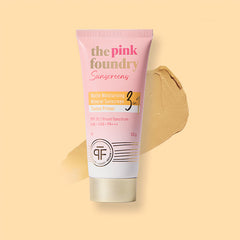Salicylic Acid Vs Benzoyl Peroxide: Difference And Which One Is Better For Acne
Millions of individuals throughout the world suffer from acne, a common skin condition that leaves them frustrated and eager for effective treatments. Two stand out among the abundance of acne-fighting components: salicylic acid and benzoyl peroxide. These substances have a wide range of applications in different skincare products, but they each fight acne in a different way.
In this article, we'll examine the advantages of salicylic acid and benzoyl peroxide, evaluate their efficacy, and eventually guide you toward choosing an efficient skincare regimen.
Benefits of Salicylic Acid and Benzoyl Peroxide
It's important to comprehend the distinctive advantages that each of these acne-fighting substances offers before comparing them:
Let’s explore the benefits of salicylic acid:
1. Exfoliation
Salicylic acid is a beta hydroxy acid (BHA) that is renowned for its capacity to enter deeply into pores. By eliminating surplus oil and dead skin cells, it exfoliates the skin's surface and clears clogged pores. This action helps stop fresh outbreaks of acne.
Also Read: How to choose the right exfoliant for your skin?
2. Anti-Inflammatory
Salicylic acid contains anti-inflammatory qualities, which allow it to lessen the inflammation and redness linked to acne lesions. For people with sensitive skin, it is a good alternative because it calms inflamed skin.
Elimination of Blackheads and Whiteheads
Salicylic acid removes blackheads and whiteheads by dissolving the keratin plugs that obstruct hair shafts. This procedure aids in the removal of pre-existing acne scars.
Let’s look at the benefits of benzoyl peroxide:
1. Antibacterial
Benzoyl peroxide is a substance that fights germs, namely the acne-causing Propionibacterium acnes (P. acnes) bacteria. It aids in preventing the development of new acne lesions by lowering the bacterial growth on the skin.
2. Oxidation
Because P. acnes is anaerobic and cannot thrive in the presence of oxygen, benzoyl peroxide can inhibit its growth by introducing oxygen into the pores.
3. Comedolytic
Benzoyl peroxide, like salicylic acid, has a little exfoliating effect. It facilitates the removal of dead skin cells and keeps them from blocking pores.
Salicylic Acid vs. Benzoyl Peroxide
Let's now examine the main difference between salicylic acid and benzoyl peroxide:
1. Mechanism of Action
Salicylic acid is more effective for treating non-inflammatory acne, like blackheads and whiteheads, since it exfoliates the skin and clears clogged pores. Benzoyl peroxide, in contrast, is more suited for treating inflammatory acne, which is characterised by red, swollen pimples and pustules.
2. Irritation Potential
Salicylic acid seems to be gentler to the skin than benzoyl peroxide in terms of potential irritation. Sensitive or dry-skinned people may usually like it better. On the other hand, benzoyl peroxide, especially at greater doses, can be more drying and may result in redness and peeling.
3. Skin Types
Salicylic acid's ability to control oil makes it a popular recommendation for those with a combination skin type or oily skin. Although benzoyl peroxide is appropriate for a variety of skin types, those with oily skin may prefer it more.
4. Color and Stain
If not handled correctly, benzoyl peroxide has the unusual property of bleaching clothes and pillows. Salicylic acid does not pose a risk in this regard.
5. Accessibility
Salicylic acid and Benzoyl peroxide are both easily accessible over the counter in a range of skincare products, including cleansers, spot treatments, and leave-on treatments. In rare circumstances, a prescription may be necessary for benzoyl peroxide at higher doses.
Also Read: Salicylic Acid Uses for Skin and How to Use it
Which Products to Opt for?
Your particular skin type and acne conditions will determine whether you should use salicylic acid or benzoyl peroxide. Here is a guide to assist you in selecting the right product:
1. Salicylic Acid Products
- Salicylic acid is a good option if you have non-inflammatory acne, such as blackheads and whiteheads. Find cleansers, toners, or spot treatments that include salicylic acid as an active component.
- If you have sensitive or dry skin, think about using a lesser concentration (between 0.5% and 2%) of the product.
- Depending on how well your skin tolerates it, incorporate salicylic acid into your skincare regimen by using it once or twice daily.
2. Benzoyl Peroxide Products
- Benzoyl peroxide can be useful in lowering bacterial activity if you have inflammatory acne with red, puffy pimples or pustules. Choosing products with concentrations between 2.5% and 10% is preferable; start with lower doses to reduce irritability.
- To prevent potential bleaching, use caution while handling clothing and bedding.
3. Combination Therapy
Salicylic acid and benzoyl peroxide may be used together in specific circumstances. This strategy addresses both bacterial infection and blocked pores. To maintain healthy skin, it's essential to apply moisturisers and sunscreens as needed because mixing these chemicals might be drying.
'Overnight Acne Spot Corrector' and 'Clearing & Calming Acne Face Wash' (1.5% Salicylic Acid) from The Pink Foundry combine to successfully treat acne. The salicylic acid face wash gently exfoliates and relaxes the skin, while the spot corrector targets blemishes overnight, providing cleaner, healthier skin.
Conclusion
Both salicylic acid and benzoyl peroxide are effective treatments for acne, providing unique advantages for various acne types and skin conditions. Your individual requirements and skin type should guide your decision between these components.
Salicylic acid exfoliates and soothes without causing excessive dryness, making it a good choice for people with sensitive skin and non-inflammatory acne. However, because of its antibacterial qualities, benzoyl peroxide is more effective against inflammatory acne.











